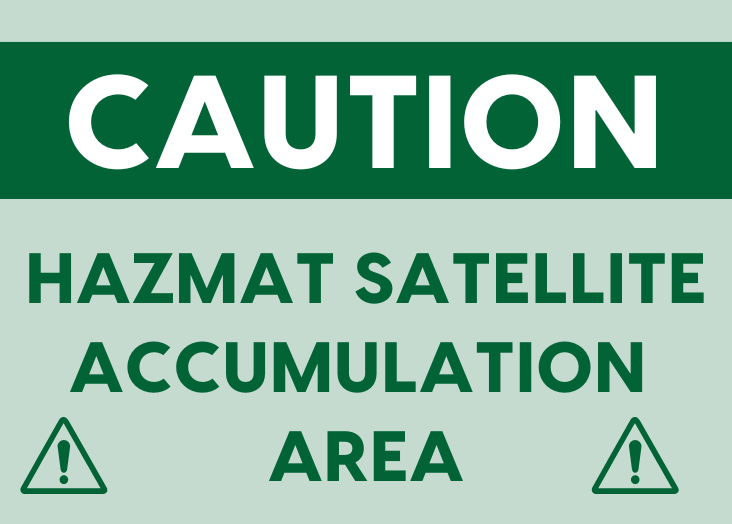Top 5 SAA Hazardous Waste Violations
Triumvirate Environmental’s operations teams provide onsite support services to hundreds of customers across the country. As part of these services, we utilize our ADVISE™ software to manage many of our customers' Resource Conservation and Recovery Act (RCRA) compliance programs, including satellite accumulation area (SAA) inspections.
We've configured our operations to provide unique and specific hazardous waste services to the life sciences, higher education, healthcare, and high-tech manufacturing sectors. Recently, we aggregated compliance data from all the SAA inspections across our customer portfolio to come up with this top five hazardous waste-related violations list.
1. SAA and Open Containers
The most common SAA compliance violation we observe is that of open containers. To understand the problem and come up with the best compliance solution, we studied the various types of open containers. The violation types include:
- Container top not secured: We often see containers with their tops—but these are unsecured when not being filled. Examples include: funnels that are not closed; caps left off or not tightened; or containers left open even when not being filled.
- Open process waste containers: Our customers operate many high-performance liquid chromatography (HPLC) and other lab scale process and analytical machines. Manufacturers of these machines design the waste lines, but stop there: the machines usually do not come with an RCRA-compliant container to collect the waste. Unclosed empty 4-liter bottles or other containers are often used to collect this waste. To address this issue, Triumvirate Environmental has developed a VOCLok solution—designed to collect waste through a closed system. It also helps labs with HPLC machines stay compliant with container closure requirements.
- Containers that don’t close: Sometimes we find waste containers compatible for the waste they hold—but they are lacking tops that close properly. In this case, we suggest evaluating the waste stream and identifying a container designed for the safe and compliant collection and management of the particular hazardous waste involved.
2. Improper Labeling and SAAs
This is another common compliance issue—one with several root causes. With our programs, we make a concerted effort to provide a site-wide labeling system for hazardous waste. Here, we standardize the label type and provide very specific training for filling out the label compliantly.
However, given the specific RCRA labeling requirements, we still find labels filled out incorrectly. Sometimes they are missing information—such as the identity of the waste type and associated hazards. As to be expected, in states with the most requirements, we see more labeling errors and issues.
At those sites where waste programs are more decentralized (or where there is not a uniform labeling system), we will see waste without any label—let alone one filled out correctly. As stated above, we have found implementing a standard site-wide labeling system helps with managing this compliance issue.
3. SAAs and Incompatible Waste Stored Together
Some SAAs collect waste derived from multiple processes. When this occurs, there is a risk of storing two incompatible waste types in the same SAA. We often see this in research labs with multiple small containers collected in the same SAA.
Common examples of incompatibles stored together are mixed acid and base waste streams—or flammable and oxidizer waste streams stored together. We recommend separating the waste streams by storing each in its own container—so they can then be managed in one SAA or two. What’s important is that you eliminate the risk of the two streams reacting from a leaking or broken waste store storage container.
4. Leaking Containers
Many of the sites we manage have hundreds of SAAs throughout them. Frequently, the SAAs are collecting waste from HPLC or other smaller scale process machines. We frequently find leakage or spillage in these SAAs, which may result from:
- Waste lines improperly draining into a waste container: This widespread problem sometimes arises when a line is pulled out of the waste container—or the line doesn’t properly feed into a waste container.
- Overfilling a process waste container: This frequently causes leaking containers. In this scenario, handlers didn’t change out a waste container fast enough—so the waste spills out of the collection container.
5. No/Incorrect Hazardous Waste Determination
The fifth common SAA violation we observe in the field is that of an incorrect or missing waste determination. Remember, a waste determination must be made at the point of generation (POG)—and the material must be managed as a hazardous waste at that time.
- Substance not managed as a waste: Frequently, I review waste programs with individual waste generators. Together, we often identify a container at the POG collecting hazardous waste—but the substance isn’t managed as a waste. Generators often explain this by saying that once the container is full, they have someone pick it up or move it. This is a violation, however—the material must be collected as a waste at the POG.
- No formal determination: We also see a material that resembles a waste but lacks a formal determination. When we find these materials, we inquire about them, and often find that the material was, in fact, a waste. However, a determination was never conducted on it, and so it wasn’t properly managed.
- Improper waste characterization: Finally, we sometimes find wastes that are not properly characterized. Sometimes the individuals generating the waste are not familiar with the requirements' particulars. Because of this, they don’t select the correct hazard or accurately identify the constituents. At other times, their determinations are wrong because they do not have analytical capabilities—or their assessment, based on “generator knowledge,” was not thorough.
Summary: SAA Compliance
Maintaining full compliance with an SAA program can be very difficult—especially at a large site with many SAAs. However, through a comprehensive inspection program—with thorough follow-up and coaching—generators can significantly reduce the number of violations, and manage them if they arise. This reduces the site’s overall violation risk.
Triumvirate Environmental’s hazardous waste inspection program and ADVISE™ software are essential parts of our onsite services program. This component of the service brings data and compliance actions to our customers’ sites. This results in greater compliance for client generator programs.
If you would like to learn more about satellite accumulation area compliance, Triumvirate Environmental’s ADVISE™ and inspections programs, or our comprehensive onsite support services, talk to us today.






.png)
